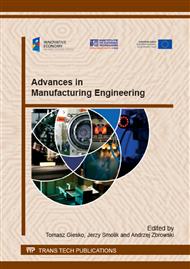[1]
T. Giesko, A. Mazurkiewicz, A. Zbrowski, Advanced mechatronic system for in-line automated optical inspection of metal parts, International Journal of Simulation: Systems, Science & Technology. 90 (2010) 36 – 41.
Google Scholar
[2]
S. Krimmel, J. Stephan, J. Baumann, 3D computed tomography using a microfocus X-ray source: Analysis of artifact formation in the reconstructed images using simulated as well as experimental projection data, Nuclear Instruments and Methods in Physics Research A. 542 (2005).
DOI: 10.1016/j.nima.2005.01.171
Google Scholar
[3]
J. Y. Buffiere, E. Maire, J. Adrien, J. P. Masse, E. Boller, In Situ Experiments with X ray Tomography: An Attractive Tool for Experimental Mechanics, Experimental Mechanics. 50 (2010) 289–305.
DOI: 10.1007/s11340-010-9333-7
Google Scholar
[4]
W. Ludwig, A. King, P. Reischig, M. Herbig, E. M. Lauridsen, S. Schmidt, H. Proudhon, S. Forest, P. Cloetens, S. Rolland du Roscoat, J.Y. Buffiere, T.J. Marrow, H.F. Poulsen, New opportunities for 3D materials science of polycrystalline materials at the micrometre length scale by combined use of X-ray diffraction and X-ray imaging, Materials Science and Engineering A. 524 (2009).
DOI: 10.1016/j.msea.2009.04.009
Google Scholar
[5]
K. Pałka, B. Szaraniec, Analiza mikrostruktury spieków tytanowych z gradientem porowatości przy zastosowaniu rentgenowskiej mikrotomografii komputerowej, Engineering of Biomaterials. 15 (2012) 26-30.
Google Scholar
[6]
L. Babout, E. Maire, J. Y. Buffière, R. Fougères, Characterization by x-ray computed tomography of decohesion, porosity growth and coalescence in model metal matrix composites Acta Materialia. 49 (2001) 2055–(2063).
DOI: 10.1016/s1359-6454(01)00104-5
Google Scholar
[7]
L. Babout, E. Maire, R. Fougères, Damage initiation in model metallic materials, X-ray tomography and modelling, Acta Materialia. 52 (2004) 2475–2487.
DOI: 10.1016/j.actamat.2004.02.001
Google Scholar
[8]
J. Kastner, H. Harrer, P. Degischer, High resolution cone beam X-ray computed tomography of 3D-microstructures of cast Al-alloys, Materials Characterization. 62 (2011) 99-107.
DOI: 10.1016/j.matchar.2010.11.004
Google Scholar
[9]
J. Kastner, B. Harrer, G. Requena, O. Brunke, A comparative study of high resolution cone beam X-ray tomography and synchrotron tomography applied to Fe-and Al-alloys, NDT&E International. 43 (2010) 599-605.
DOI: 10.1016/j.ndteint.2010.06.004
Google Scholar
[10]
E. Maire, L. Babout, J.Y. Buffiere, R. Fougères, Recent results on 3D characterisation of microstructure and damage of metal matrix composites and a metallic foam using X-ray tomography, Materials Science and Engineering A. 319-321 (2001).
DOI: 10.1016/s0921-5093(01)00924-8
Google Scholar
[11]
E. Maire, A. Fazekasb, L. Salvob, R. Dendievelb, S. Youssefa, P. Cloetensc, J.M. Letangd, X-ray tomography applied to the characterization of cellular materials. Related finite element modeling problems, Composites Science and Technology. 63 (2003).
DOI: 10.1016/s0266-3538(03)00276-8
Google Scholar
[12]
S. Roux, F. Hild, P. Viot, D. Bernard, Three-dimensional image correlation from X-ray computed tomography of solid foam, Composites: Part A. 39 (2008) 1253-1265.
DOI: 10.1016/j.compositesa.2007.11.011
Google Scholar
[13]
P. Viot, E. Plougonven, D. Bernard, Microtomography on polypropylene foam under dynamic loading: 3D analysis of bead morphology evolution, Composites Part A. 39 (2008) 1266-1281.
DOI: 10.1016/j.compositesa.2007.11.014
Google Scholar
[14]
A. Zbrowski, Tomografia rentgenowska w diagnostyce syntetycznych koszy łożysk tocznych, Energetyka. 2 (2013) 132-139.
Google Scholar
[15]
Cs. Kádár, E. Maire, A. Borbély, G. Peix, J. Lendvai, Zs. Rajkovits, X-ray tomography and finite element simulation of the indentation behavior of metal foams, 13th International Conference on the Strength of Materials, Materials Science and Engineering A. (2004).
DOI: 10.1016/j.msea.2004.03.091
Google Scholar
[16]
L. Salvo, P. Cloetens, E. Maire, S. Zabler, J. J. Blandin, J. Y. Buffière, W. Ludwig, E. Boller, D. Bellet, C. Josserond, X-ray micro-tomography an attractive characterisation technique in materials science, Nuclear Instruments and Methods in Physics Research B. 200 (2003).
DOI: 10.1016/s0168-583x(02)01689-0
Google Scholar
[17]
H. Toda, T. Ohgaki, K. Uesugi, M. Kobayashi, N. Kuroda, T. Kobayashi, M. Niinomi, T. Akahori, K. Makii, Y. Aruga, Quantitative Assessment of Microstructure and its Effectson Compression Behavior of Aluminum Foams via High-Resolution Synchrotron X-Ray Tomography, Metallurgical and Materials Transactions A. 37A (2006).
DOI: 10.1007/s11661-006-1072-0
Google Scholar
[18]
O. Lame, D. Bellet, M. Di. Michiel, D. Bouvard, In situ microtomography investigation of metal powder compacts during sintering, Nuclear Instruments and Methods in Physics Research B. 200 (2003) 287-294.
DOI: 10.1016/s0168-583x(02)01690-7
Google Scholar
[19]
S. Burch, Measurement of density variations in compacted parts using X-ray computerized tomography, Metal Powder Report. 57 (2002) 24-28.
DOI: 10.1016/s0026-0657(02)85009-3
Google Scholar
[20]
W. Węglewski, K. Bochenek, M. Basista, Th. Schubert, U. Jehring, J. Litniewski, S. Mackiewicz, Comparative assessment of Young's modulus measurements of metal–ceramic composites using mechanical and non-destructive tests and micro-CT based computational modeling, Computational Materials Science. 77 (2013).
DOI: 10.1016/j.commatsci.2013.04.007
Google Scholar
[21]
K. Karbowski, Podstawy rekonstrukcji elementów maszyn i innych obiektów w procesach wytwarzania, Wydawnictwo Politechniki Krakowskiej, Cracow, (2008).
Google Scholar
[22]
J. Gawlik, J. Sładek J, A. Ryniewicz, M. Kowalski, A. Gąska, Wielofunkcyjna ocena jakości urządzeń technologicznych i wyrobów, Inżynieria Maszyn. 15 (2010) 20-34.
Google Scholar
[23]
A. Ryniewicz, Wykorzystanie wzorców do oceny dokładności odwzorowania zarysu w tomografii komputerowej, Pomiary Automatyka Kontrola. 1 (2010) 66-67.
DOI: 10.15199/48.2015.06.17
Google Scholar


